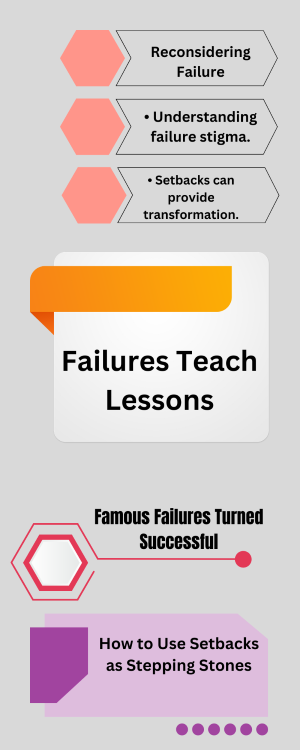Failure is Not a Big Blunder: Embracing Setbacks as Stepping Stones

Table of Contents
Introduction: Reconsidering Failure
• Understanding failure stigma.
• Setbacks can provide transformation.
A Misunderstanding of Failure
• Failure as evidence of effort.
• Dispelling failure misconceptions.
Failures Teach Lessons
• Developing resilience via failure.
• Promoting creativity via errors.
• Aligning with growth possibilities.
Famous Failures Turned Successful
• J.K. Rowling: From Disapproval to Global Success.
• Michael Jordan: Motivation via failure.
• Elon Musk: Redefining space innovation failures.
How to Use Setbacks as Stepping Stones
• Changing your view of failure.
• Analyzing post-failure data.
• Taking little steps towards goals.
• Creating a supporting network.
The Role of Self-Compassion
• Kindness towards self after failure.
• Embracing work above results.
Failure as a Stepping Stone
• Seeing failure as a step towards success.
• The phoenix analogy: Resilience after failures.
Conclusion: Turning Setbacks into Opportunities
• Failure may be a turning point, not a death end.
• Embrace the growth path with encouragement.
Introduction: Reconsidering Failure
Failure can seem like striking a wall, making aspirations appear unattainable, and self-doubt seep in. What if that “wall” represents the start of something bigger? Failure is inevitable and transforming, but society makes us dread it. Failure may lead to success if accepted. This article explains why setbacks are good and how they may improve results.

A Misunderstanding of Failure
Failure as evidence of effort
Every endeavor, successful or not, shows guts and effort. Learning to ride a bike requires crashing, yet each fall improves balance and resolve. Life failure also symbolizes development. Edison said, “I have not failed. I discovered 10,000 ways to fail.”
Dispelling failure misconceptions
Instead of avoiding failure, learn from it.
The finest instructors are mistakes. Each setback—a failed company concept or unachieved personal goal—teaches us what to change, avoid, or better.
Failures Teach Lessons
1. Developing resilience via failure
We must try again after failure. This process builds emotional toughness, preparing us for future struggles. Each failure teaches tenacity, a key success trait.
2. Promoting creativity via errors
When things go wrong, we must think differently. The failure led to some of the world’s greatest innovations:
• The Microwave Oven: Found an accident when a researcher’s chocolate bar melted near a radar tube.
• One of the most successful office gadgets, Post-it Notes, originated from a failed adhesive attempt.
3. Aligning with growth possibilities
Failure prompts reflection and goal reassessment. It sometimes guides us toward our abilities or ambitions.
Famous Failures Turned Successful
- J.K. Rowling: From Disapproval to Global Success
Rowling struggled financially and was rejected by many publishers before writing Harry Potter. Persistence turns failure into success, as her tale shows.
• Michael Jordan: Motivation via failure
Jordan transformed his expulsion from his high school basketball team into an inspiration to become a legend.
- Elon Musk: Redefining space innovation failures.
SpaceX’s early failures nearly bankrupted Musk, but he persevered and revolutionized space travel.
These instances demonstrate that failure frequently leads to success.
How to Use Setbacks as Stepping Stones
1. Changing your view of failure
See failure as input, not a verdict. Instead of asking, “Why did this happen to me?” ask, “What can I grasp from this?”
2. Analyzing post-failure data
Identify the decisions or activities that caused the outcome.
Develop strategies to ward off similar situations in the future.
When analyzed curiously, failures can lead to success.
3. Taking little steps towards goals
Failure dread shouldn’t immobilize you. Reduce big ambitions to doable stages. Celebrate minor accomplishments to stay motivated.
4. Creating a supporting network
Befriend those that motivate you. Mentors, peers, and friends can help you accept failure.
The Role of Self-Compassion
Kindness towards self after failure
Self-compassion implies being gentle to oneself when things are rough. After failing, it’s tempting to condemn yourself, yet self-compassion may help you heal.
Embracing work above results
Remember the courage of trying. You deserve praise even if the conclusion wasn’t what you wanted.
Failure as a Stepping Stone
Seeing failure as a step towards success.
Each failure is a ladder rung. It may feel like a setback, but it’s helping you reach your goals.
The phoenix analogy: Resilience after failures.
After the defeat, we frequently become stronger and wiser, like the phoenix. Each failure is a chance to innovate.
Conclusion: Turning Setbacks into Opportunities
Failure signals development, creativity, and achievement, not a mistake. Accepting failure lets you learn, adjust, and move forward with clarity.
Next time you fall, don’t give up. Consider it proof of your movement, learning, and growth. Remember that every great person you respect started where you are—at the intersection of failure and perseverance.
Call to Action:
Consider how your prior failures influenced you. Tell your narrative to change how others view failure.
